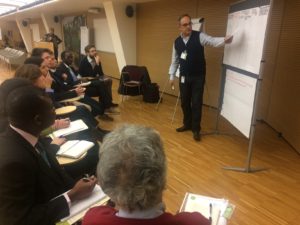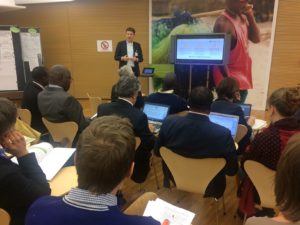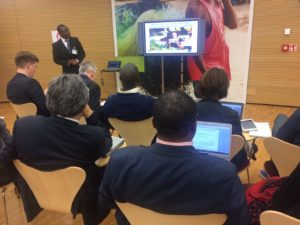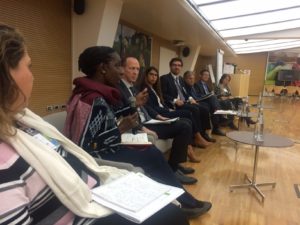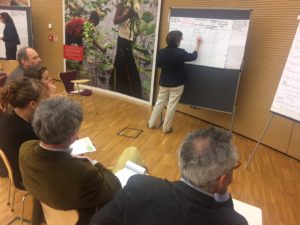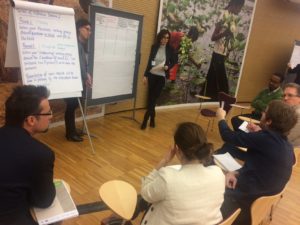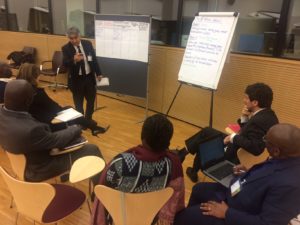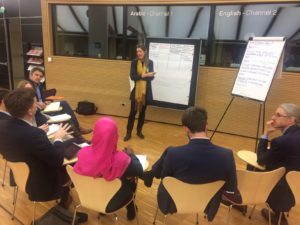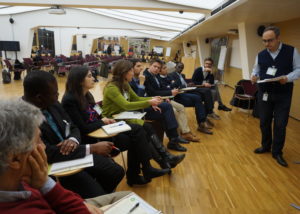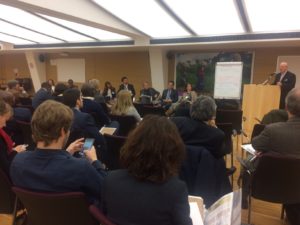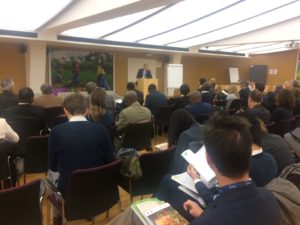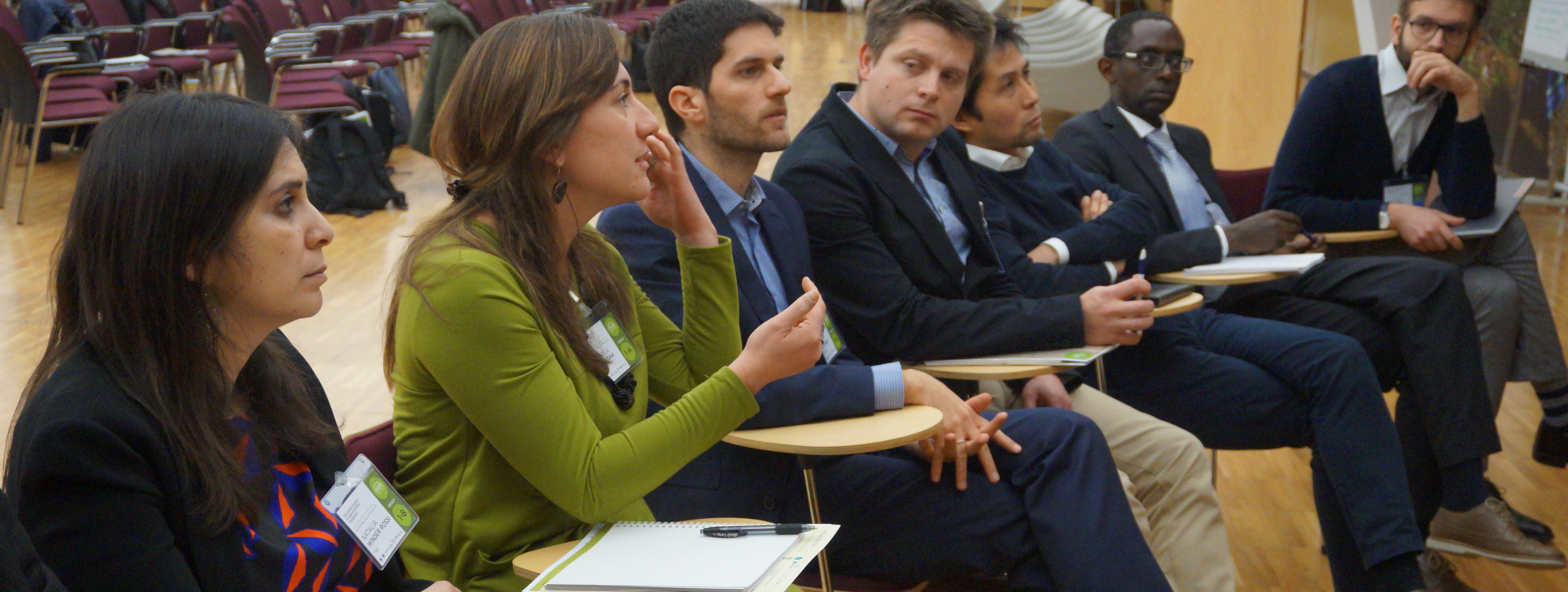
Good and accessible information is the main requirement for an efficient management of agricultural risks. The Platform for Agricultural Risk Management (PARM) in collaboration with other partners has organized an International Workshop on Information Systems for Agricultural Risk Management (IS-ARM) in order to explore gaps and opportunities. The workshop was hosted by IFAD Headquarters in Rome, Italy on the 31st of January, 2017.
PARM in collaboration with other development partners organized a knowledge sharing event in Rome, hosted by IFAD on the 31st of January 2017. The main objective of the workshop was to lead collaborative dialogue and build partnerships among the different thematic experts and development partners, private sector and government to facilitate the collection of recommendations on how to make accessible information and develop harmonized information systems to enhance investments in agriculture to manage risks. During the event it was also released PARM Study on “Informational Assessment of Agricultural Risk Management Information Systems (ARM-IS)” in 7 Africa Countries.
The Context
Information is the main raw material for agricultural risk management (ARM). Without information there is no way to assess the likelihood and severity of different risks, no way to be prepared in advance or improve resilience, nor to agree on how to manage or transfer the risk to others. Information from different sources on markets, climate and weather, diseases, inputs and technologies is the “light” that is needed to manage risks. Information systems play a broader role for agriculture, for good business practices, to improve livelihoods, increase productivity and ensure efficient value chains. Risk management is among the most information intensive aspects of agriculture, because of the deep information needs in terms of disaggregation in the space and evolution and changes over time.
Information about production, prices and diseases is key to assess farming risks and to find the most appropriate risk management strategies. Long historic inter and intra-annual information, and disaggregated data for specific locations is particularly useful for this purpose. Indeed information is the key input for most management and risk management decisions in the farm. In addition, exposure to these risks prevents farmers from easily planning ahead and making investments. In turn, risk inhibits external parties’ willingness to invest in agriculture because of the uncertainty about the expected returns.In this context, where taking decisions on how to best manage the complex farming risks scenario requires reliable, timely and accessible information, the need for better information systems becomes more and more crucial.
At the same time information systems are significantly evolving in recent times, in terms of the type and amount of information that is and can be gathered, but also in terms of who collects and hosts the information and how it can be accessed. Information and communication technologies are generating a revolution in terms of satellite, sensor and geospatial data, access through mobile devices, and collection of unstructured but Big Data. This revolution is particularly relevant in agriculture because it has a particular larger incidence on remote areas that before had less information collected and worse access. This is a big opportunity for agricultural risk management. For the insurance industry to develop new products and fill information gaps; for the financial institutions to be able to manage the risks from the agricultural sector; for farmers to improve their resilience and enhance their investments in the farm and in the household; for governments to better design their policies.
The Study
To respond to the Government demands, PARM has committed a study on “Informational Assessment of Agricultural Risk Management Information Systems (ARM-IS)” in 7 Africa Countries: Cabo Verde, Cameroon, Ethiopia, Mozambique, Niger, Senegal and Uganda. The purpose of the study is to investigate the availability and quality of information for agricultural risk management purposes and the timely and useful access by stakeholders at micro-meso-macro[1] level. At country level, the scenario reflects often information systems thematic-focused and not integrated and harmonized in a more holistic system. There are significant gaps in information collection and access that often occur in a systematic manner across countries. These gaps create asymmetries and inefficiencies in the management of risks in the agriculture sector.
[1] Micro level refers to farmers, households and local communities; meso level refers to firms and supply chain actors; macro level refers to governments.
The Workshop
As part of the broader objective of PARM to strengthen the creation and sharing of knowledge among stakeholders and raising awareness on ARM, the Platform, following Government demands, has identified information systems as a main limiting factors to assess and manage risks and therefore make informed decisions and investments in agriculture to develop ARM tools in several sub-Saharan African countries.
The publication of the study was a good occasion for PARM organizing a knowledge sharing event to bring together practitioners from public sector, private sector, the farming community, and the development community together to share experiences and innovations on information systems for agricultural risk management, through panels and group sessions to draw recommendations on how to make accessible information and develop harmonized information systems to enhance investments in agriculture.
For this reason, the main objective of the workshop was to lead collaborative dialogue and knowledge-sharing among the different thematic experts and facilitate the collection of recommendations on how to make accessible information and develop harmonized information systems to enhance investments in agriculture.
OBJECTIVES:
- Identify the specific information needs for agricultural risk management such as the type of information and sources, and the characteristics of the information in terms of time series availability and geographical disaggregation.
- Identify the main information gaps for agricultural risk management in terms of availability, accessibility and quality. Accessibility is understood as usability of the information by final users (farmers, governments, private sector…) for risk management purposes.
- Share knowledge and specific experiences on how information and communication technologies are already covering gaps in terms of information collection, sharing, analysis and accessibility.
- Share experiences on how different types of partnerships or institutional arrangement between different stakeholders and initiatives from the public and private sector and from national and international agencies, can create opportunities for access and use of information for agricultural risk management.
The Programme
The workshop was structured into three main session:
Session 1. Setting the scene: information systems for agricultural risk management
Session 2. Information Systems: sources, tools and accessibility
Session 3. Information Systems: applications and innovation for risk management
Session 4. Integration of information systems in decision-making: the way forward
See full Workshop Programme.
Workshop 10 Take-Aways
by Professor Jose Maria Sumpsi, CEIGRAM
1. Why so intense information for Agricultural Risk Management (ARM) is needed:
- Different products (crops, fruit and olive trees. Vineyards, livestock…)
- Different types of risks and hazards (climate, market, health, policy and others)
- Different type of farming (familiar, commercial, small or large farms)
- Long time series of data to know the frequency and severity of hazards
- Being able to evaluate the impacts, socially, economically and environmentally
- Being able to perform forecasting
2. The information needed for ARM is context specific:
The context is defined in full along the dimensions identified in the previous point.
3. Key role of the new technologies and tools:
- ICT (markets, climate/meteorological, plant and animal production and health)
- Remote Sensing (early warning systems, index insurances)
- Big Data (Holistic approach combining different thematic blocks of information)
4. There are numerous and diverse information systems for ARM: international, regional, national, private and public IS
As an example, in Ethiopia 103 information systems on seven thematic blocks were found: 39 national, 15 regional and 49 international. Just in the thematic block on price and markets 22 information systems, not always complementary, were found: 11 national, 5 regional and 6 international.
The harmonization and coordination of the existing Information systems within the different thematic blocks is a key element for ensuring that all these elements of information and the systems supporting it enable feasible and useful ARM.
5. The main requirements of information for ARM are:
Standardization, disaggregation and tailored according to the needs of the users, including the dissemination means, the format and the language.
6. Accessibility of Information Systems:
Is a very important issue but the severity is different depending on the nature of users: policy makers, public institutions, experts from universities and research centers, banks and insurance companies and value chain actors. The problem of accessibility is particularly severe in the case of farmers in remote and poor rural areas. We may distinguish three types of accessibility problems:
a. Limited openness of some information systems and sources due to:
- legal regulations on confidentiality
- information available in public offices but not disseminated
- payment to access to the information
b. Limited dissemination of information systems and sources due to:
- difficulties to disseminate in local languages
- lack of connectivity in rural areas to access to IS websites
- websites not working properly
- very limited amount of information can be disseminated through radio and sms
- radio and sms are good for early warning due to its high coverage
- limited coverage of farmers organizations
- limited coverage of public administration offices in rural areas
- difficulties to read bulletins
- problems to understand and interpret full and elaborated information
7. Sustainability
In the case of public information systems the sustainability will depend on public budget allocations and donor contributions.
In the case of private information systems the sustainability will depend on the willingness to pay from users (farmers and other actors of the food chain, banks, insurance companies, dealers, others)
- Willingness to pay in turn will depend on benefit for users from the information
- The information should be embedded in broader services (marketing, dealers, technical assistance) to facilitate sustainability
- The regional approach (regional networks IS) may contributes to sustainability
8. Importance of farmers participation, either individually or through farmers organizations to:
- define the needs of farmers information
- establish the best way to disseminate the information to the farmers
- participate in the governance of information systems
- provide valuable information for IS through crowd sourcing schemes
- build capacity to allow farmers to interpret and digest the information
9. The Holistic approach is one way forward to improve the information for ARM:
The Holistic approach is based on the articulation/combination of the different type of information systems and sources (public, private, international, regional and national), the different thematic blocks of information and the different technologies and tools for collecting (surveys, networks of qualified informants, remote sensing, crowd-sourcing and others) and disseminating (cell phones-sms, websites, radio, TV, bulletins, farmer organizations, local offices from governments). Big data can be a useful tool for the holistic approach. The optimal combination of different technologies and tools will depend on the kind of information (short early warning messages or long time series of data) and is context specific.
10. There is a great deal of innovations on information systems for ARM:
Eighteen innovations were presented in Session 3 covering very diverse and good initiatives on e.g. Big Data (MUIIS Uganda), private system offering information and broader services (FIRM Uganda), Pooling Insurances (African Risk), Social protection (FAO), Early warning for animal health (FAO-Empres), Regional price and market information (RATIN), African Food Price through crowd-sourcing (pilot project from JRC) and others. It would be good to have systematic information on that innovations to make a sound follow-up.
Read More
- IS-ARM Workshop Report – Volume 1 – Main Report
- IS-ARM Workshop Report – Volume 2 – Presentations
- Information System for Agricultural Risk Management Study – Executive Summary Report
- IS-ARM Country Policy Briefs

